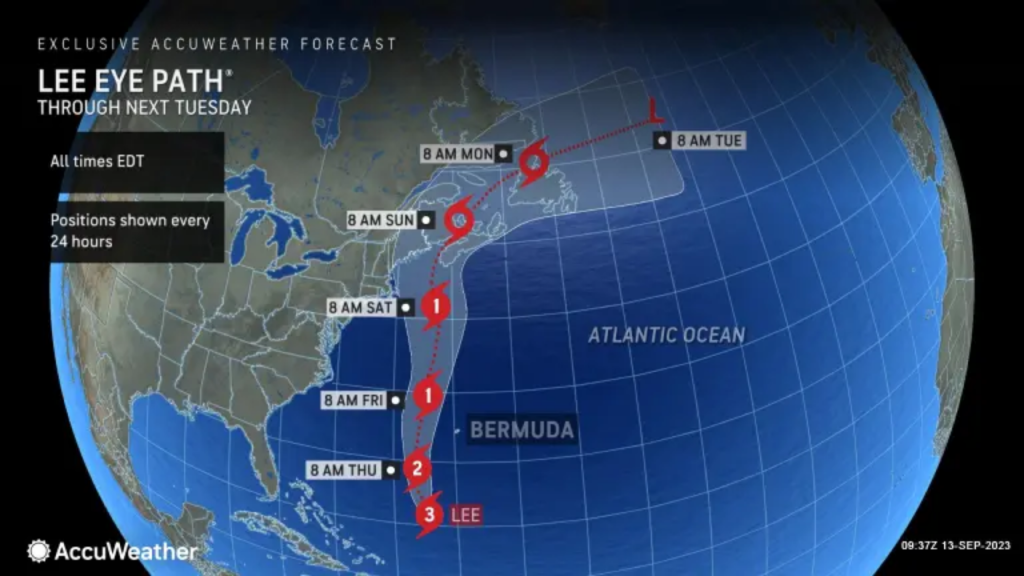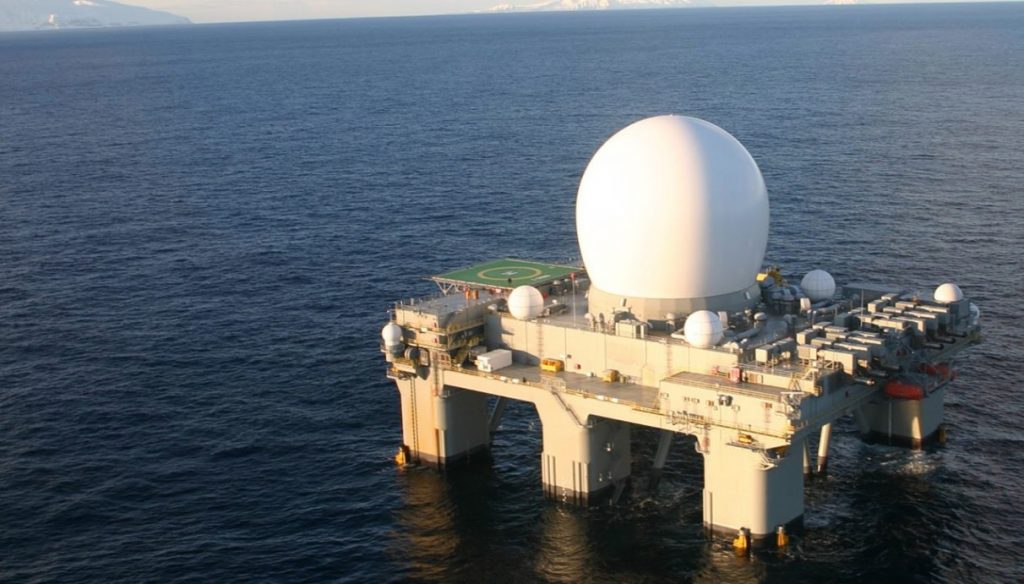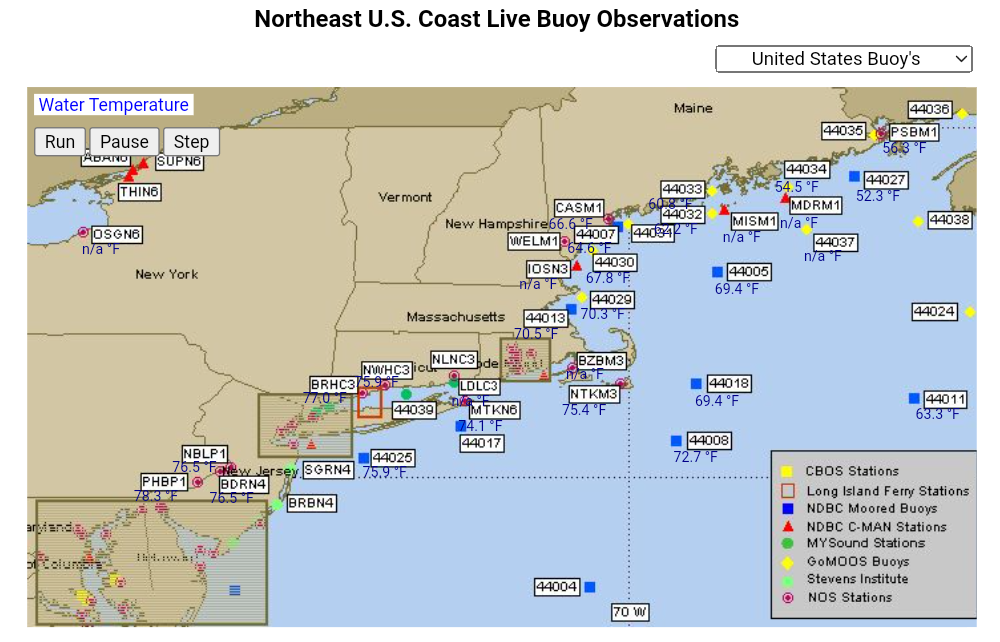
Hurricane Lee’s sudden intensification and predicted turn left towards Canada’s East Coast indicates that the hurricane is being steered by an ionosphere heater. The speed of the hurricane provides evidence that it is being controlled by the slow moving sea based ionosphere heater, the SBX-1.
As of early Tuesday afternoon, Lee was packing 115 mph winds and moving west-northwest at a virtual crawl of just 6 mph.
Hurricane Lee is moving very slow because it is being controlled. Note that the SBX-1 ionosphere heater has a maximum speed of approximately 8 knots (9.2 mph; 15 km/h).
New World Order advocate Joe Biden redeployed the SBX-1 for political gain in March of 2023. He was installed as President of the United States to assist the U.S.’s WWI and WWII enemy, Germany, “create a New World Order”- a world government under German control.
The current location of the SBX-1 is classified because it is being used and has been used for weather warfare by the US government. It was extensively used by the Barack Obama and Joe Biden administration. It sat unused at its port in Hawaii throughout President Donald Trump’s administration.
Even though the SBX-1 ionosphere heater location is classified the Canadian government and the governments of the U.S. states on the East Coast can still locate it using cell phone tracking. The crew of the SBX-1 use cell phones to communicate with their families on land. Monitor their cell phone communications to locate the position of the SBX-1.
Canadian government agencies in Nova Scotia, New Brunswick and Newfoundland and agencies of U.S. East Coast states can also monitor the North Atlantic water and air temperatures to prove that an ionosphere heater is controlling and steering Hurricane Lee. A sudden rise in water temperatures ahead of Hurricane Lee provides ample evidence that the North Atlantic ocean’s air and waters are being heated by an ionosphere heater, to intensify it and steer it into Canada’s Maritime provinces.
All hurricanes need warm water — at a temperature of at least (minimal) 79 degrees F. Hurricanes take in the heat from warm waters, which gives them power. This time of the year the North Atlantic doesn’t have the warm water needed to fuel or sustain a hurricane. The Buoy for Halifax harbor (screenshot above) confirms that the recorded water temperature is currently 67.1°F, not the 79°F that is needed to fuel a hurricane. 63°F water temperature is internationally recognized as cold water. Cruise ships, merchant ships and navy vessels crew members know that it is.
All along the Northeast U.S. Coast the water temperatures are too cold to intensify or even fuel Hurricane Lee. Screenshot below taken September 13, 2023 at 8:23PM Atlantic Time confirms that the U.S. East Coast water temperatures are not warm enough to intensify or sustain Hurricane Lee.
The U.S. National Weather Service statement regarding hurricanes:
“The first condition is that ocean waters must be above 26 degrees Celsius (79 degrees Fahrenheit). Below this threshold temperature, hurricanes will not form or will weaken rapidly once they move over water below this threshold.”
How ionosphere heaters create and steer hurricanes
The UK’s Telegraph reported from Washington DC in 2007 on how a ionosphere heater can steer a hurricane:
“With small changes (in temperature) to this side or that side of the hurricane we can nudge it & change its track (steer it)” MIT Moshe Alamaro
US Eastlund patent informs you how a ionosphere heater can form a hurricane.
Ionosphere heaters can create a column-shaped hole with a diameter of 30 miles that rises a couple of hundred kilometers through the atmosphere. The lower atmosphere then moves up the column to fill in that space, and it changes pressure systems below. The result of hot surface air being sucked up into the column to fill the ionosphere heaters created column-shaped hole is a hurricane (if the ionosphere heater column-shaped hole is made over water) or a tornado (if ionosphere heater column-shaped hole is made over land).
The April/May 2000 issue of Scientific American contained an article on the effects of altering the course of the jet stream. This slight change to the jet stream path occurred right above the HAARP facility. That little movement created a storm front 4,000 miles away in east Texas and Louisiana to move into central Florida where it triggered a couple of tornadoes. This article gives evidence that ionosphere heaters like HAARP Alaska, the US Navy’s SBX-1, the US Air Force’s X-37B and Germany’s EISCAT ionosphere heaters can induce/cause climate change thousands of miles away with only a slight change to the jet stream path.
Todd Pedersen, a scientist at the Air Force Research Laboratory’s Space Vehicles Directorate at Kirtland Air Force Base in Albuquerque, New Mexico confirmed that ionosphere heaters do in fact heat the ionosphere.
“Its powerful radio waves drive ionospheric electrons back and forth in what are called plasma waves. As those driven electrons collide with each other and with background species, their temperature goes up, which is why HAARP is called a heater.”
“the HAARP antenna can heat the ionosphere at specific altitudes where the transmission frequency simultaneously matches two resonances.”
In 1998 Bernard Eastlund completed a paper on how to knock out tornadoes using a space-based, solar-collecting microwave generator, which he called the Thunderstorm Solar Power Satellite.
The orbiting satellite (e.g. the U.S. Air Force’s Boeing X–37B) would heat the rainy downdraft inside the storm using its microwave X-band phased array antenna to manipulate the convective forces needed to concentrate the tornado’s power and either intensify it and create and steer a tornado or stop it from forming. That paper was presented in Italy and it was so widely accepted that NASA and FEMA contracted Bernard Eastlund to do further research on weather modification using satellite-based technology – U.S. Air Force Boeing X–37B.
“Mesocyclone Diagnostic Requirements for the Thunderstorm Solar Power Satellite Concept” Published in the Proceedings of “The Second Conference on the Applications of Remote Sensing and GIS for Disaster Management”, Jan. 19-21, 1999, Sponsored by NASA and FEMA
The Jet Stream Solar Power Satellite is described by Eastlund as “a dual use Satellite which can focus microwave energy into a jet stream to change the direction (steer) of a jet stream. It does this by triggering turbulence in the flowing air which decreases the flow velocity of an edge region of the flow and generating a pressure differential that changes the direction of the bulk air flow.“






